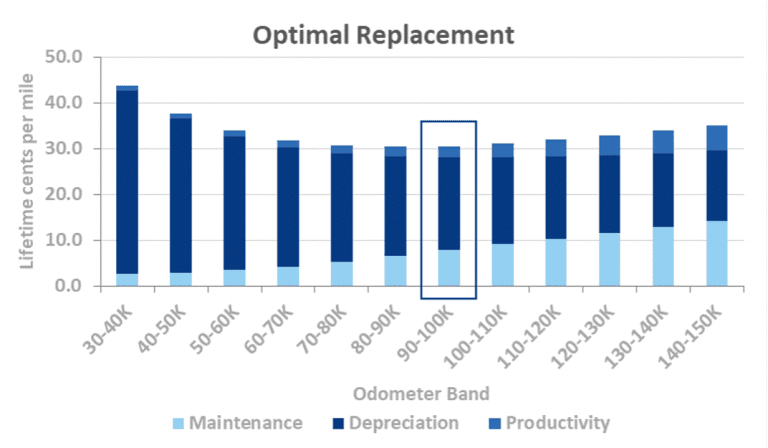Blog Post
Optimal Fleet Replacement Strategies: Finding the Sweet Spot by Balancing Quantitative and Qualitative Factors
By Patti Danapilis
August 1, 2024
Implementing a solid fleet vehicle replacement strategy can feel like a juggling act. You are balancing costs, safety, employee satisfaction, and the environmental impact of your fleet. So, let us explore the key considerations and strategies for optimal fleet vehicle replacement, blending both quantitative and qualitative factors to help you make the best decisions for your fleet.
Quantitative Factors
The largest single cost of a vehicle is depreciation. This cost is at its highest point at the very start of a vehicle’s life and decreases over time as the book value decreases. In contrast, maintenance costs start out low, and remain low for the first year and then gradually ramp upward as vehicles age.
Analyzing the total cost of ownership (TCO) over a fleet vehicle’s lifecycle is fundamental to determining the best time to replace it. Key parameters include:
- Depreciation: Fleet vehicles lose the most value in the beginning of the lifecycle. Replacing too soon means high depreciation costs, while waiting too long ramps up maintenance expenses.
- Maintenance Costs: These start low due to warranties but climb as the vehicle ages.
- Productivity Loss: Older fleet vehicles are more prone to breakdowns, leading to downtime and lost productivity.
- Fuel Efficiency: Older fleet vehicles typically guzzle more fuel, driving up operational costs.
By combining depreciation, maintenance, and productivity costs, at different replacement scenarios, you can determine the optimal replacement point – when the cost of operating a vehicle is the lowest. In the example below, this point occurs at 90-100K miles.

Qualitative Factors
Aging vehicles present other challenges for fleets. They expose companies to safety risks, a greater need to keep additional surplus vehicles sitting dormant, or a detrimental perception of the company due to the image aging fleet vehicles project. Here are some of the qualitative factors to layer into your optimal replacement strategy.
Brand Image – Newer fleet vehicles reflect a client’s commitment to quality and innovation, boosting your company’s reputation. A fleet that’s regularly updated projects a forward-thinking image that can attract clients and partners.
Employee Retention and Satisfaction – Newer, more efficient fleet vehicles make employees feel safer and valued more which may improve overall driver morale and reduce turnover. Companies with newer fleets report higher driver satisfaction and lower turnover rates.
Safety – Safety is paramount. Newer vehicles come equipped with advanced safety features like automatic emergency braking and lane departure warnings. Ensuring your fleet vehicles meet the latest safety standards protects drivers and reduces liability risks. One company saw a 15% drop-in accident rates after taking advantage of modern safety features.
Environmental Compliance – As regulations evolve, older fleet vehicles may no longer meet environmental standards. Replacing them with newer, more efficient models helps comply with regulations and reduces your carbon footprint. Transitioning to fuel-efficient fleet vehicles and accelerating replacement parameters led to a 20% reduction in overall emissions for one company.
The Sweet Spot – Balancing Costs and Benefits
Every organization will have their own sweet spot based on their unique fleet needs and priorities. You must weigh the financial and operational impacts of replacement decisions. Evaluate cost savings from reduced maintenance, fuel efficiency and resale value against the capital expenditure of new fleet vehicles. Replacing high-mileage fleet vehicles with newer models can significantly cuts maintenance costs and fuel consumption.
By combining these quantitative and qualitative factors, fleet managers can develop an optimal vehicle replacement strategy that minimizes overall costs, enhances safety, and supports organizational goals. Implementing a structured and data-driven approach leads to improved efficiency, safety, and overall fleet performance. Talk to your Fleet Consulting Executive to determine best replacement parameters for vehicles in your fleet, or contact us to learn how Wheels can help optimize your fleet strategy.

Data Strategist, Client Analytics